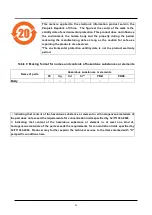
SK00-4167-DI-002-07
16
3.
Gas-ballast Valve
This product is installed with the gas ballast function as standard. PVD-180-H, -360-H has no gas
ballast valve.
Breathed condensed gas shall be liquefied through the compress process of the Pump, mixed with
the Pump oil and then cycled mixed together inside the Pump unit. This status brings you the same
situation that you used the high steam pressure oil that raises the ultimate pressure. It also shortens
the life cycle of the Shaft seal since the oil lubrication shall deteriorate.
If introduced the air or dry nitrogen through the gas ballast valve just before the Pump compression
process, the condensed gas is not liquefied but exhausted with the air through the Exhaust valve.
To use the gas ballast, breathe in the air through the gas ballast valve before sucking in the
condensed gas and operate the Pump around twenty minutes; this is because the “gas ballast effect”
becomes larger as the Pump temperature is higher. Wait until the Pump temperature raises enough to
open the Vacuum Valve so as to operate the Pump. The “gas ballast effect” under low temperature
shall be lower than the specified process performance.
Note further that keeping the gas ballast valve open when not breathing in the condensed gas shall
cause the Pump oil splashing and power loss and further rise the ultimate pressure. You have to note
also that the condensed gas might remain in the Pump oil after you have exhausted a lot of condensed
gas or exhausted the condensed gas (air or gas that contains less water or other steam that
contaminates the oil) without opening the gas ballast valve since the process capacity of the condensed
gas by the gas ballast valve is limited.
In such a case, close the Main valve, breathe in the air through the gas ballast valve and idle operate
the Pump. Then the oil temperature shall rise up and be cleaned by means of the Gas ballast effect.
Keep on idle operating the Pump without opening the gas ballast valve as far as the specified ultimate
pressure is attained. You need to replace the Pump oil if it was not cleaned after operated long time.
Note: The Vacuum pump gets high temperature during operation. As the gas ballast valve also gets
high temperature, be sure to wear protective gear such as a pair of gloves.
Note: Ensure to close the gas ballast valve to start operating the Pump. The oil might jet out of the gas
ballast valve during the operation around high pressure range.
Note:
The guaranteed pressure resistance of this pump is 0.03 MPa (0.3 kg / cm2) (gauge pressure).
Operate the supply pressure of the gas ballast gas to be introduced within the following range.
Supply pressure: Atmospheric pressure to 0.03 MPa (0.3 kg / cm2 (gauge pressure)) or less.
4.
Vacuum Pump Oil ULVOIL R-42 for Winter Use
In winter, if the pump could not be started easily, check the following points carefully. [Belt-tension,
Motor fuse, smoothness of rotation of the pump, etc.]. In spite of normal behavior for the check points,
if the pump could not be started easily, please replace oil to ULVOIL R-42.
Note: It is better to use the ULVOIL R-42 having less viscosity that enables you to start rotating the
Pump around 4
℃
. Replace it with the ULVOIL R-72 if the temperature gets 10
℃
or more. Be
cautious as using the ULVOIL R-42 in warm season would cause such troubles as sealing error,
oil leak or more serious trouble, due to its lower viscosity.
Note: ULVOIL R-42 is unfitted for high load operation. When performing the high load operation, use
ULVOIL R-72, and either warm the Pump oil or perform the Pump jog at several times, and start it
up.
Summary of Contents for PVD-180
Page 2: ......
Page 11: ...SK00 4167 DI 002 07 7 Fig 4 Dimensional drawing PVD 180B Fig 5 Dimensional drawing PVD 360B...
Page 37: ......
















































